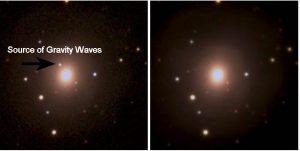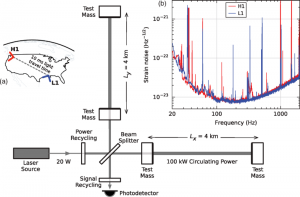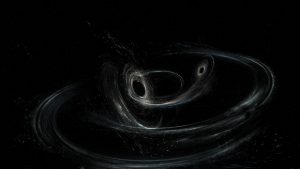The past week has been quite an exciting one for astronomy and the scientific community in general. We already knew a part of the story; indeed I mentioned it in a previous post (7Oct17). As a reminder, back on the 17th of August this year the LIGO gravity wave observatories in Hertford Oregon and Livingston Louisiana along with the new Virgo detector in Italy announced that they had made the third ever detection of gravity waves. We now know however, that was just the start of the story.
You see, even as the detectors at LIGO and Virgo were gathering their measurements, in orbit above the Earth the Fermi Gamma Ray Space Telescope was also busy detecting a Gamma Ray Burst, a short sharp pulse of gamma rays that occurs about once a day somewhere in the Universe. Gamma ray bursts are known to be amongst the powerful events ever seen.
Could these two completely different instruments have detected the same event, and if so could other astronomers with other telescopes also observe the event?
Boy did they. Within literally seconds emails were being sent out to astronomers around the world giving the approximate location of the event, a small region in the constellation of Hydra. As quickly as possible other astronomers were using their instruments see what they could find.
It was the Swope telescope at Cerro Las Campanas observatory in Chile that succeeded in finding the exact location, inside the galaxy NGC 4993 at a distance of about 130 million light years. Within hours four more telescopes were also making observations and by the next day the Chandra X-ray Space telescope, the Swift Ultra Violet Space telescope along with the Very Large Array Radio telescope in New Mexico had joined in.
The image below is the event as seen by the Dark Energy Camera at the Cerro Tololo Interamerican Observatory, also in Chile. The picture on the right shows the area of the sky before the event while the picture on the left shows a tiny new dot above the bright object in the center. That small dot is the source of the gravity waves and gamma ray burst.

The event, which has been given the names GW170817 for the gravity wave observation and GRB170817A for the gamma ray burst, has become one of the most studied phenomenons in the history of science. A compendium paper of all of the observations has been submitted to ‘The Astrophysics Journal’ with 4,500 listed authors from 910 institutions. That’s about one third of all professional astronomers in the world.
So what was the event, and what did we learn for it. First of all the observations are consistent with our theories about the merger of two neutron stars into either a larger neutron star or more likely a black hole. And as for what we learned, it’s a little too soon to tell but the fact that our theories were so close indicates that we are making great progress in our understanding of some of the rarest and most powerful events in the Universe. The image below shows an artist’s representation of a neutron star merger.

In some ways however, the most impressive thing about the observations of 17August is that the new gravity wave detectors have now been integrated into an ever growing network of astronomical observatories. This network has been developed over the last ten years or so and uses the Internet to maintain instantaneous cooperation between some of the most advanced instruments ever developed. In this way astronomers around the world are ready at a moment’s notice to swing into action to study the most powerful and transient events in the Universe.
All of the papers written thus far have been from observing astronomers; the theoreticians haven’t had the time to study the data. When they do they’ll refine their models and make new predictions. Based on those predictions the observatories will have a better idea of what to look for the next time.
This is how we progress, getting closer to the truth with each event we study. The gravity wave observatories are a new way of looking at the Universe and so far it appears that we’re going to be learning a lot from them.


